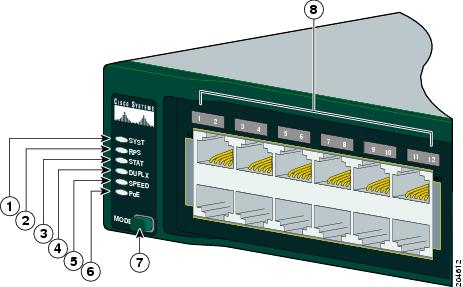- Cisco Community
- Technology and Support
- Networking
- Switching
- Cisco 2960 sytem led
- Subscribe to RSS Feed
- Mark Topic as New
- Mark Topic as Read
- Float this Topic for Current User
- Bookmark
- Subscribe
- Mute
- Printer Friendly Page
Cisco 2960 sytem led
- Mark as New
- Bookmark
- Subscribe
- Mute
- Subscribe to RSS Feed
- Permalink
- Report Inappropriate Content
05-24-2017 05:45 AM - edited 03-08-2019 10:42 AM
My cisco 2960 sytem led is flashing orange when powered on and static amber when working normal,rest all is working properly at room temprature(25 C) and when temprature is raised above 40 C its configeration file is erased.
- Labels:
-
Other Switching
- Mark as New
- Bookmark
- Subscribe
- Mute
- Subscribe to RSS Feed
- Permalink
- Report Inappropriate Content
05-24-2017 08:02 AM
Hi
Below you will find more information about the led status, if the system led is Amber, it is receiving power but probably has any hardware problem, including the power supply. If you have a Cisco contract, a ticket with the Cisco TAC should be opened to create a RMA.
Reference: http://www.cisco.com/c/en/us/td/docs/switches/lan/catalyst2960/hardware/installation/guide/2960_hg/higover.html
LEDs
You can use the switch LEDs to monitor switch activity and its performance. Figure 1-23 shows the switch LEDs and the Mode button that you use to select one of the port modes.
All LEDs are visible through the GUI management applications—Network Assistant for multiple switches and the device manager for a single switch. The switch software configuration guide describes how to use the CLI to configure and to monitor individual switches and switch clusters.
Only the Catalyst 2960 PoE switches have a PoE LED.
The four Catalyst 2960 8-port switches and these models do not have an RPS connector or an RPS LED: Catalyst 2960-24-S, Catalyst 2960-Plus 24TC-S, 2960-24TC-S, 2960-48TT-S, 2960-Plus 48TC-S, 2960-48TC-S.
Figure 1-23 Catalyst 2960 Switch LEDs

|
|
|
||
|
|
|
PoE LED1 |
|
|
|
|
||
|
|
|
|
|
System LED
The System LED shows whether the system is receiving power and is functioning properly. Table 1-2 lists the LED colors and their meanings.
|
|
|
|---|---|
RPS LED
The RPS LED shows the RPS status. Table 1-3 lists the LED colors and their meanings.

Note![]() The Catalyst 2960 8-port switches, and the Catalyst 2960-24-S, 2960-Plus 24TC-S, 2960-24TC-S, 2960-Plus 48TC-S, 2960-48TC-S, and 2960-48TT-S switches do not have an RPS LED.
The Catalyst 2960 8-port switches, and the Catalyst 2960-24-S, 2960-Plus 24TC-S, 2960-24TC-S, 2960-Plus 48TC-S, 2960-48TC-S, and 2960-48TT-S switches do not have an RPS LED.
For more information about the Cisco RPS 2300 or the Cisco RPS 675, see the related hardware installation guide for that power system.
Port LEDs and Modes
The port LEDs, as a group or individually, display information about the switch and about the individual ports ( Table 1-4 ):
|
|
|
|
|---|---|---|
|
SPEED2 |
||
|
PoE3 |
|
2.When installed in Catalyst 2960 switches, 1000BASE-T SFP modules can operate at 10, 100, or 1000 Mb/s in full-duplex mode or at 10 or 100 Mb/s in half-duplex mode. |
Even if the PoE mode is not selected, the PoE LED shows PoE problems when they are detected ( Table 1-5 ). The PoE LED applies only to Catalyst 2960 switches that support PoE.
To select or change a mode, press the Mode button until the desired mode is highlighted. When you change port modes, the meanings of the port LED colors also change. Table 1-6 explains how to interpret the port LED colors in different port modes.
Please rate the comment if it is useful
:-)
>> Marcar como útil o contestado, si la respuesta resolvió la duda, esto ayuda a futuras consultas de otros miembros de la comunidad. <<
Discover and save your favorite ideas. Come back to expert answers, step-by-step guides, recent topics, and more.
New here? Get started with these tips. How to use Community New member guide


